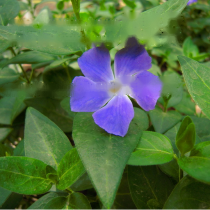
Chinese name: Vinca major L.
Alternative name: Periwinkle
Genus: Periwinkle
Species: Periwinkle
Distribution area: Mediterranean coast, America, India and other places
1. Morphology of Periwinkle
Periwinkle is a trailing subshrub, the stem veins are lying down, but the flower diameter is upright, the calyx, corolla throat and leaf margins, petioles have hairs, and there are no hairs elsewhere. The leaves are oval in shape, two to six centimeters in length, and one-and-a-half centimeters to four centimeters wide. There are about four pairs of lateral veins, and the petiole is one centimeter long. Flowers solitary, growing in leaf axils. The length of the pedicel is four or five centimeters, the lobes of the calyx are narrowly lanceolate, and the length is nine millimeters. is circular.
2. Habits of Periwinkle
Periwinkle is native to the Mediterranean coast, America, India and other places. It is cultivated in Jiangsu, Shanghai, Zhejiang, Hubei and Taiwan in China. Periwinkle likes warm and humid, likes sunshine and is more shade-tolerant, slightly cold-tolerant, and likes to grow in deep, fertile and moist soil. Periwinkle is both heat-resistant and cold-resistant, evergreen in all seasons, and has strong vitality. It is an ideal ground cover plant. And its gorgeous color, has a high ornamental value.
3. Cultivation of Periwinkle
Periwinkle can be propagated by seed sowing. Spring sowing in April. Vinca genus has 750 seeds per gram, and the optimum temperature for germination is 18-24°C. Use a seeding tray to hold the mixed soil of disinfected leaf mulch, culture soil and fine sand, and germinate 14-21 days after sowing. After emergence, at noon with strong light and high temperature, it needs to be shaded for 2-3 hours. When the seedlings are 5 cm high and have 3 pairs of true leaves, they can be potted. The periwinkle should not be wet and afraid of waterlogging, and the basin soil should not be watered too much, as excessive humidity will affect the growth and development. In particular, indoor winter plants should strictly control watering, preferably dry, otherwise they are very susceptible to freezing. Cultivation in the open field, rain showers in midsummer, pay attention to timely drainage, so as to avoid the death of the whole area caused by waterlogging.
Guess you like it
Egg Fruit | Snakeberry | Gourd | Mountain Grape | Dodder | Pepper | seven | Radix Codonopsis| Dibromide| Schisandra|
Ding Gong Teng| Jade Leaf Golden Flower| Bronze Root | Fishing Rat | Butterfly Pea| | Violet | Anthurium |
Narcissus | Cyclamen | Impatiens | Sparrow | Pearl Plum | Nasturtium | Wenguanguo|
![[Dog Training 5] The training method of pet dog dining etiquette](/static/img/12192/12192_1.jpg)




